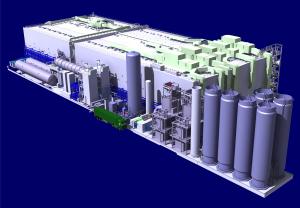Deliveries
Last cryogenic tanks from Europe
30 Oct 2017
Eleven storage tanks have been delivered by the European Domestic Agency in the past year for the ITER cryoplant, including two this past week.
The European-procured tanks are all stored horizontally on the ITER platform for the moment. However as seen in the image below, many of them will move to a vertical position when installed in their final location.
The fabrication of the tanks for the ITER cryoplant was undertaken by European contractor Air Liquide and its subcontractors in such faraway locations as Sweden, the Czech Republic, China and Turkey, while logistics were handled by ITER's global logistics provider, DAHER.
One of the most technically challenging tanks will be capable of storing up to 20 tonnes of liquid helium (LHe), or 85 percent of the 24 tonnes of liquid helium that will be circulating in the ITER installation during operation. The double-wall vessel measures 25 metres in length.
The ITER cryoplant, under construction now, comprises 5,400 m² of covered buildings plus a large exterior area for the storage of helium and nitrogen.
Ten other tanks—six gaseous helium (GHe) tanks, one liquid nitrogen tank (LN2), one gaseous nitrogen tank (GN2), and two quench tanks for the storage of helium expelled from the ITER magnets in the case of a quench—are also needed as part of the cryoplant infrastructure.
Read the full report on the European Domestic Agency website.
The ITER cryoplant will provide liquid helium and liquid nitrogen to major clients for cooling. Cooling fluids generated in the cryoplant will travel along process lines installed 13 metres above platform level on a bridge that runs to the Tokamak Building; from there, approximately five kilometres of cryolines will distribute gas and liquid helium to the different "users." The ITER magnets will consume 45 percent of cryogenic power followed by the thermal shield (40 percent) and the cryopumps (15 percent).
The tanks will be installed in a 2,600 m² exterior storage area near the cryoplant, where a concrete platform has been prepared.
Read the full report on the European Domestic Agency website.



